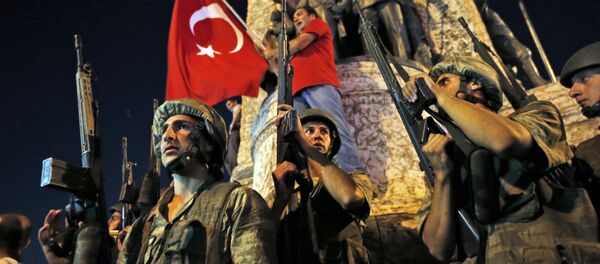The nuclear yield of the B-61 can be adjusted to suit a particular mission, from 0.3 kilotons to as many as a hundred and seventy kilotons.
On Saturday morning, commercial power was cut to the base and the airspace above it was closed; US Air Force planes stationed there were prohibited from taking off or landing.
On Sunday, the base commander, General Bekir Ercan Van, and nine other Turkish officers at Incirlik were detained for allegedly supporting the coup in the country.
As the base continues to rely on backup generators, the US media is speculating whether the nuclear weapons stockpiled there are secure and hard to reach.
“The air base operates under Turkish and US commands. There would be a fence, guarded most likely by Turkish military personnel. Not an impermeable barrier, to be sure, but an early warning to those further inside. During a coup, the air base goes on high alert, which would mean that facilities inside were locked down and additional guards deployed,” Cheryl Rofer affirms in her article for the website War on the Rocks.
“Inside both the outer fence and guards are more fences and guards around the more secure areas, probably including operations areas and headquarters. The nuclear weapons storage area at Incirlik has two fences with a cleared area and sensors in between. Those in search of a nuclear weapon need to know which fenced area is their target,” she further states.
However Eric Schlosser, the author of “Fast Food Nation” and “Command and Control: Nuclear Weapons, the Damascus Accident, and the Illusion of Safety,” refutes her claims in his article for The New Yorker.
He says that NATO’s hydrogen bombs are still guarded by the troops of their host countries.
He also recalls that in 2010, peace activists climbed over a fence at the Kleine Brogel Airbase in Belgium, cut through a second fence, entered a hardened shelter containing nuclear-weapons vaults, placed anti-nuclear stickers on the walls, wandered the base for an hour, and posted a video of the intrusion on YouTube.
Schlosser also refutes Cheryl Rofer’s claim that the weapons are hard to reach due to being kept in underground vaults.
“The weapons are on racks that rise out of the ground. The controls probably require keys or codes. This is not a vault that one can walk into, like a bank vault. The weapons are heavy and require probably two or three men to handle, unless a dolly is available,” she says.
“Anyone trying to extract these weapons will have to beat the security while under armed attack by base personnel. 'Shoot to kill' will be part of the rules of engagement.”
Additionally, in order to detonate a nuclear weapon, a mechanism called a Permissive Action Link (PAL) must be engaged. This is a security device that requires a code be entered, possibly in addition to other electronic actions, before the weapon can be detonated.
Schlosser however argues that “with a few hours and the right tools and training, you could open one of NATO’s nuclear-weapons storage vaults, remove a weapon, and bypass the PAL inside it.”
“Within seconds, you could place an explosive device on top of a storage vault, destroy the weapon, and release a lethal radioactive cloud,” he adds.
“Yes, the bombs are stored in vaults, inside protective aircraft shelters, inside a security perimeter and require special codes to arm them. But none of these features are intended to protect the weapons against a host nation that attempts to seize them. They can buy time, but that is all,” he writes for The New York Times.
“These weapons serve no purpose. Neither Turkish aircraft nor U.S. aircraft in Turkey can deliver the bombs. The United States Air Force regards them as an expensive distraction from the mission of countering the Islamic State. The Turkish government regards them as a political liability that shouldn’t be mentioned,” he adds.
He finally states that a recent Air Force review found that security at all the foreign airbases that host US nuclear weapons was inadequate.








